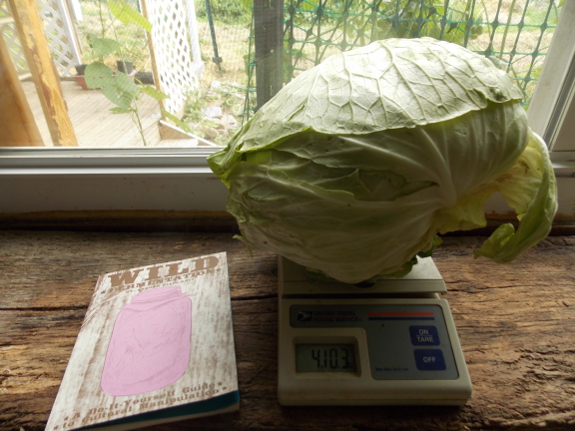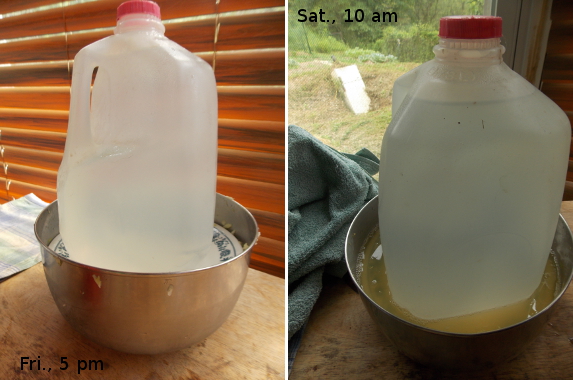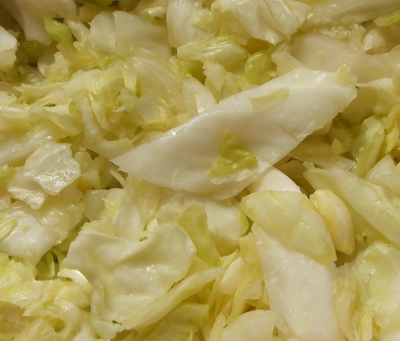
Sandor Katz and sauerkraut

As Mark mentioned,
we decided to try making sauerkraut for the first time this year.
My reasoning was two-fold. First, although we had fun
experimenting with kefir,
when we stopped using the fermented milk product for a while, Mark's
stomach felt better, not worse, so we're still looking for the proper
probiotic to keep him healthy. And, second...I grew an absurd
number of cabbages this spring and they have to go somewhere.
Of course, when I want to
try something new, I head straight for the books. Sandor Katz is
the poster child for fermented foods at the moment, and he has several
titles out on the topic. I'd heard that his Wild Fermentation is the basic book for beginners, so even though it pained me to pass up Katz's 500 page The Art of Fermentation, I decided to save that lengthy tome for a treat in case we decide we do like sauerkraut.

Unfortunately, I didn't research quite far enough, and got the very small, booklet version of Wild Fermentation (subtitled "A Do-It-Yourself Guide to Cultural Manipulation") rather than the expanded version with the same title (but subtitled "The Flavor, Nutrition, and Craft of Live-Culture Foods").
If any of you are following in my footsteps, the book I read is fun and
beautifully laid out, but is very short --- I'd recommend upgrading to
the longer version of Wild Fermentation. Or just start with Katz's sauerkraut recipe, which you can read for free online.

Anyway, to cut a long
story short, I mixed up my first batch of sauerkraut in a matter of
minutes Friday evening, and the salty juices soon filled the bowl.
Since we don't have a big ceramic crock, I followed one website's
advice and figured a stainless-steel bowl would do. On the other
hand, I liked Katz's recommendation of using a jug of water on top of a
plate as a weight --- simple and free.
 I
do have one observation even before we taste the sauerkraut --- the
recipe is absurdly salty. When I cook it up, half a head of
cabbage forms a meal for the two of us (yes, we're major vegetable
eaters). At nearly 3 tablespoons of salt per head of cabbage,
sauerkraut would provide three times our recommended daily allowance of
salt in one serving. Perhaps sauerkraut and similarly fermented
foods are meant to be a small garnish beside a large helping of other
vegetables?
I
do have one observation even before we taste the sauerkraut --- the
recipe is absurdly salty. When I cook it up, half a head of
cabbage forms a meal for the two of us (yes, we're major vegetable
eaters). At nearly 3 tablespoons of salt per head of cabbage,
sauerkraut would provide three times our recommended daily allowance of
salt in one serving. Perhaps sauerkraut and similarly fermented
foods are meant to be a small garnish beside a large helping of other
vegetables?
That caveat aside, making
sauerkraut was easy and fun. I'll post again soon with a
taste-test of our first batch of fermented cabbage.
Want more in-depth information? Browse through our books.
Or explore more posts by date or by subject.
About us: Anna Hess and Mark Hamilton spent over a decade living self-sufficiently in the mountains of Virginia before moving north to start over from scratch in the foothills of Ohio. They've experimented with permaculture, no-till gardening, trailersteading, home-based microbusinesses and much more, writing about their adventures in both blogs and books.
Want to be notified when new comments are posted on this page? Click on the RSS button after you add a comment to subscribe to the comment feed, or simply check the box beside "email replies to me" while writing your comment.

That's interesting. I am growing cabbage for the first time this year and I was thinking of maybe making sauerkraut, so I look forward to seeing how yours turns out.
That does seem like an absurd amount of salt. I wonder if a lot of it will be lost in the excess liquid that will form? Maybe it's necessary to have that much salt so you don't end up with any bad bacteria in there.
Anyway, good stuff.
I was into Ann Wigmore's raw vegan diet back in the 80's, and made plenty of sauerkraut. It was successful every time, and I never used salt. Here's one link. I had a different recipe, and used neither kelp nor juniper berries. I think I added some grated carrots. I did have to skim the brown crud off the top.
http://books.google.com/books?id=1aLCVVP-4_gC&pg=PA8&lpg=PA8&dq=ann+wigmore+sauerkraut+recipe&source=bl&ots=HTnyahlZTc&sig=vKph32ehZhLh04KNSIuFJDz8uUA&hl=en&sa=X&ei=MWexU4q3HsGEqgaOioLgDw&ved=0CCgQ6AEwAg#v=onepage&q=sauerkraut&f=false
Just wondering if you drink Kombucha? My husband was having some stomach problems and since I've been making it (for about 3 years), he has had no problems like before.
We're also big fans of sauerkraut and usually make 45+ quarts a year, good stuff.
The recipy you linked to uses a lot of salt (2% by weight). In Dutch recipes, 1% to 1.5% is generally advised, but you can use less. AFAIK, the salt has two uses.
In traditional Dutch recipes, the cabbage is cut and placed in the crock pot in layers. Every layer was bruised with a beechwood masher, then covered with a bit of salt and some spices.
The more you bruise the cabbage to liberate the fluids, the less salt you need to use.
A salt-free alternative is to use 15 ml (one tablespoon) of buttermilk per 2 lb of cabbage to kick-start the fermentation.
We generally sqeeze out the liquid (and most of the salt) before eating or using the sauerkraut.
Yes, fermented foods are only supposed to be used as a small side dish to the other food in the meal. For one thing, with cabbage it has goitrogens in it, so large amounts of it may have detrimental effects on some people. Variety and balance of what we eat, including ferments, is important.
However, to prevent excess saltiness I have preferred to use recipes that go by more weight and/or percentage of the cabbage and salt, at least until I become more familiar with it and do it based on experience. After all, when something says you should use "X" amount of salt for a head of cabbage, are they referring to a 3, 4, 5 or even 10 pound head of cabbage?
I haven't used this one, but this mentions the percent of salt. https://www.foodpreservationmethods.com/sauerkraut-kimchi-pickles-relishes/sauerkraut/making Also, on facebook there is a group based on the Wild Fermentation book that is very helpful. They may even suggest other types of fermented foods that may be good for Mark since milk kefir didn't seem to agree with him (there is also "water kefir" for example). https://www.facebook.com/groups/WlidFermentation/?ref=br_tf
P.S. This post (and some of the others) does not show up properly on the page for me. I have to scroll back and forth from left and right to be able to read it all.